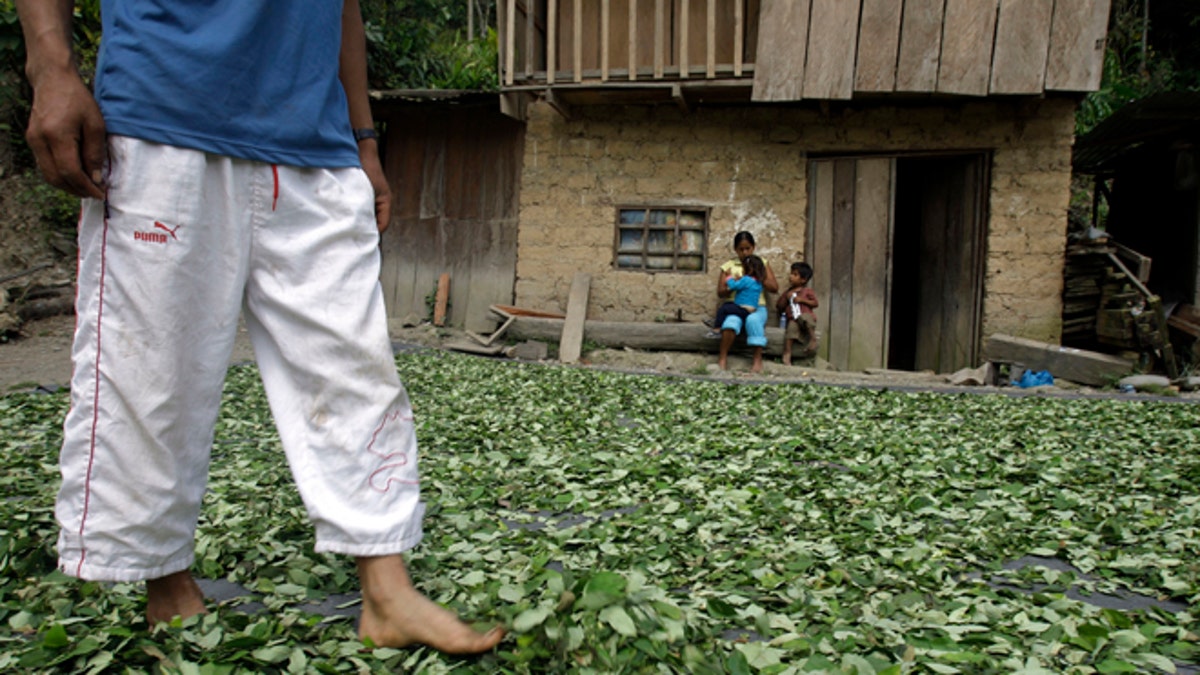
A coca farmer walks on drying coca leaves as his family looks on in Omaya in Peru's Apurimac valley. (A2009)
Lima, Peru – Peru has displaced Colombia as the world's leading producer of coca leaf, a fact that the United States has noted by increasing its anti-drug funding in the Andean nation.
More than $55 million in U.S. counter-drug assistance helped Peru eradicate 54 square miles of coca last year, and that amount was doubled to $100 million this year, half of Washington's total assistance to Peru, officials said.
Unlike Colombia, most cocaine produced in Peru is exported not to the United States but to Brazil, Argentina and Europe. Much of it is smuggled by air and land through Bolivia, the world's No. 3 coca-producing country with a crop about a third the size of Peru's.
Despite surpassing Colombia, Peru has actually cut its area under coca cultivation to 241 square miles, a decrease of 3.4 percent from 2011, the U.N. Office of Drugs and Crime said.
The agency had already said last month that Colombia's crop was down 25 percent to 185 square miles, but it held off until now with word that Peru had regained the distinction as the world's No. 1 coca leaf source that it had not held since the mid-1990s.
Peru counterdrug agency chief Carmen Masias said Colombia had the advantage of more than $6 billion in U.S. aid beginning in 2000 in trimming its coca crop. And unlike Colombia, Peru's eradication of drug crops is manual. In Colombia, U.S. contractors spray herbicide.
President Ollanta Humala made battling illicit narcotics a priority when he took office in 2011. He embraced expanded U.S. counterdrug assistance and also dedicated Peruvian funds to eradication for the first time — $11 million in 2012. Masias said Peru would likely double that next year.
Humala has in addition had success against Shining Path rebel remnants that protected drug traffickers in the Upper Huallaga Valley, the cradle of Peru's cocaine trade. It captured a top rebel there last year and is prosecuting a former congresswoman from the region for alleged drug trafficking.
The U.N. says Peru reduced the Upper Huallaga coca crop by 23 percent last year. However, coca plantations have sprung up in a new region — the Amazon jungle state of Loreto bordering Brazil and Colombia, where the U.N. said the crop was up 73 percent from 2011.
The region with the most coca in Peru — the Valley of the Ene and Apurimac rivers known as the VRAE— has some 20 percent of the crop and a strong rebel presence.
Masias has said no region of Peru is off-limits from coca eradication. But she has not said when the government might begin eradication in the VRAE.
Rebels have killed nearly 100 troops there since 2008. Last month, troops killed to two top Shining Path commanders in the region.
Based on reporting by The Associated Press.
Follow us on twitter.com/foxnewslatino
Like us at facebook.com/foxnewslatino




















